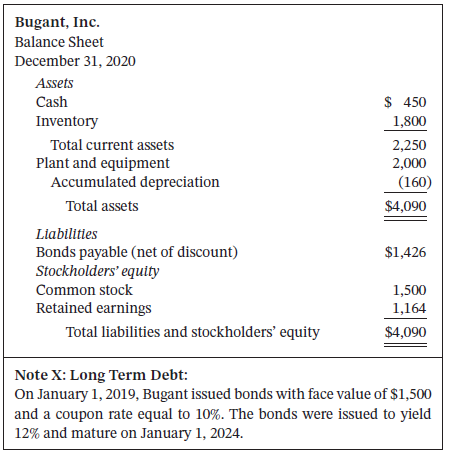The following information is taken from the 2020 annual report of Bugant, Inc. Bugant?s fiscal year ends
Question:
The following information is taken from the 2020 annual report of Bugant, Inc. Bugant?s fiscal year ends December 31 of each year. Bugant?s December 31, 2020, balance sheet is as follows.

Additional information concerning 2021 is as follows.
1. Sales were $3,500, all for cash.
2. Purchases were $2,000, all paid in cash.
3. Salaries were $700, all paid in cash.
4. Property, plant, and equipment was originally purchased for $2,000 and is depreciated straight-line over a 25-year life with no salvage value.
5. Ending inventory was $1,900.
6. Cash dividends of $100 were declared and paid by Bugant.
7. Ignore taxes.
8. The market rate of interest on bonds of similar risk was 12% during all of 2021.
9. Interest on the bonds is paid semiannually each June 30 and December 31.
Accounting
Prepare a balance sheet for Bugant, Inc. at December 31, 2021, and an income statement for the year ending December 31, 2021. Assume semiannual compounding of the bond interest.
Analysis
Use common ratios for analysis of long-term debt to assess Bugant?s long-run solvency. Has Bugant?s solvency changed much from 2020 to 2021? Bugant?s net income in 2020 was $550 and interest expense was $169.
Principles
The FASB and the IASB allow companies the option of recognizing in their financial statements the fair values of their long-term debt. That is, companies have the option to change the balance sheet value of their long-term debt to the debt?s fair value and report the change in balance sheet value as a gain or loss in income. In terms of the qualitative characteristics of accounting information (Chapter 2), briefly describe the potential trade-off (s) involved in reporting long-term debt at its fair value.
Ending InventoryThe ending inventory is the amount of inventory that a business is required to present on its balance sheet. It can be calculated using the ending inventory formula Ending Inventory Formula =... Financial Statements
Financial statements are the standardized formats to present the financial information related to a business or an organization for its users. Financial statements contain the historical information as well as current period’s financial... Solvency
Solvency means the ability of a business to fulfill its non-current financial liabilities. Often you have heard that the company X went insolvent, this means that the company X is no longer able to settle its noncurrent financial... Salvage Value
Salvage value is the estimated book value of an asset after depreciation is complete, based on what a company expects to receive in exchange for the asset at the end of its useful life. As such, an asset’s estimated salvage value is an important... Compounding
Compounding is the process in which an asset's earnings, from either capital gains or interest, are reinvested to generate additional earnings over time. This growth, calculated using exponential functions, occurs because the investment will...
Step by Step Answer:

Intermediate Accounting
ISBN: 978-1119503668
17th edition
Authors: Donald E. Kieso, Jerry J. Weygandt, Terry D. Warfiel





